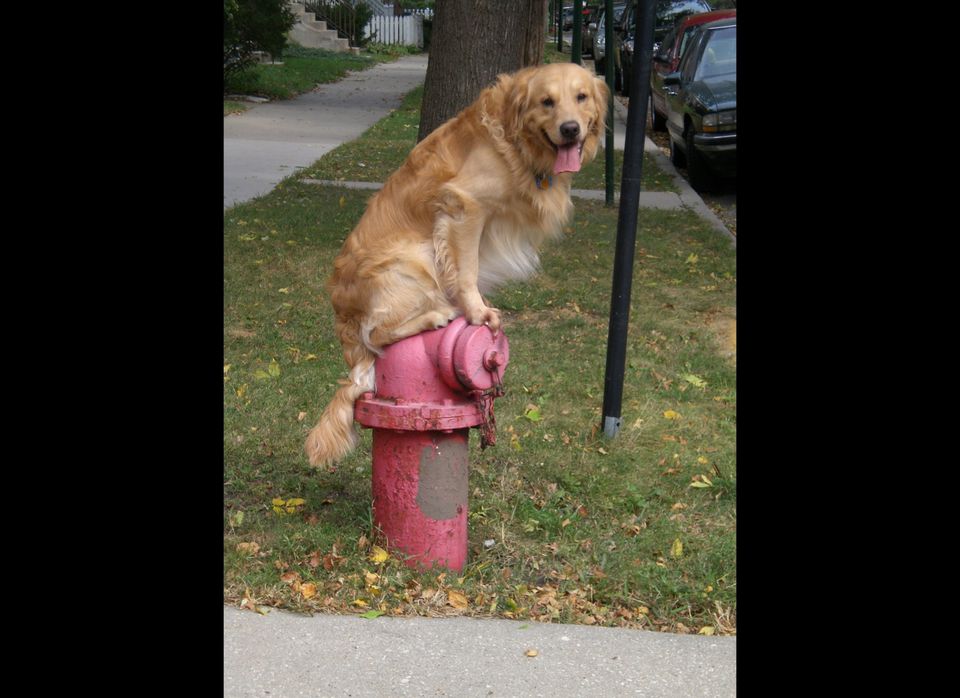It's August, and the thermometer has risen to over 85 degrees again. You are out with your best friend who always wears an impractical black fur coat. What can you do to keep her cool?
Remember that dogs rely on panting and resting in a cool place to thermoregulate (keep cool in the heat). Unlike us, dogs and all canids can't sweat to cool off. Wild canids would typically find a shady tree or bush to dig a hole under and wait out the heat of the day. Walking at the end of a leash on a city street, their options are limited. Here are 10 simple but important things you can do to keep your pet cool.
1.NEVER leave a dog in a vehicle on a warm day. Notice I didn't even say "a hot day." The sun can heat a car to more than 110 degrees on a 75 degree day in no time. Even with the windows rolled down. Your pet's life is never worth the convenience of leaving them in the car for even a few minutes. It may feel cool in the driver's seat, but the temperature in the back of any car can become dangerously hot by the time you lock the doors.
2.Know your dog. Many dogs are at high risk for heat exhaustion. These include brachycephalic dogs (smush-faced breeds like pugs and bulldogs), greyhounds, thick-furred black dogs, etc. They may not show they are overheated until it is too late. Take extra care with overweight dogs, young puppies and older pets of all breeds. They may not be able to regulate their body temperatures well in the heat. Avoid midday activities and limit their time and exercise in the hot sun and heat.
3.Prehydrate and bring plenty of water. Offer an animal plenty of water before, during and after any heat exposure. A dog will drink more water if you make it tasty. Stir in a little chicken broth, a spoonful of meat baby food or a treat, and they may drink more water. There is a caveat to water drinking -- don't let them drink too much at once or you may find they vomit the water.
4.Signs of overheating may go unnoticed or ignored in pets. Look for signs of overheating before they become serious health risks:
- Panting
- Dark pink to red tongue lolling out of mouth
- Dry, tacky mouth and mucus membranes
- Trying to lie down
- Lifting feet to avoid hot pavement
- Lameness, stumbling
- Slowing down and dragging on the leash
- Vomiting
These are all signs that a dog is too hot. Dogs will not stop running or playing if they are too hot. They will do what you tell them to do, even to the point of heat exhaustion.
5.Older dogs with a condition called Laryngeal Paralysis are more at risk for overheating and even life-threatening collapse. Dogs rely on panting for thermoregulation and the air passing through a wide open larynx can cool a dog down quickly. With Laryngeal Paralysis, a dog's larynx cannot fully open, and the thermoregulation capacity is restricted. These dogs often have louder breathing noises. This condition is also called "roarer's syndrome." Keep these dogs out of hot weather. Their life may depend on it.
6.When a pet is overheated, sponge or pour cool water on his abdomen, armpits (inguinal and axillary areas) and feet, as well as offering the water to drink. Never use alcohol to cool the skin or feet. This ill-advised method can cause toxicity through absorption of the alcohol through the dilated capillaries of the hot skin. Any dog that collapses or shows signs of severe overheating should be taken immediately to a veterinarian or ER. Intravenous or subcutaneous fluids and medical treatments could be life-saving.
7.Do not walk dogs on hot blacktop or pavement. Dogs do not show signs of pain from burnt feet until it is too late. Blisters, ulcers or even serious burns are already present when they start to limp or sometimes even fall down. Blistered feet should be attended to by a veterinarian. Relieving them with cool water is the first step. Bandages on feet should be changed regularly to avoid infection.
8.Assess the weather and logistical conditions before you bring an at-risk dog out in the heat -- especially to a parade or street party in a city. Even with shade, plenty of water, wading areas and some cool dirt a hot day can still be too much for many pets. Use common sense.
9.Don't feed your pet within an hour of exercise in the heat -- either before or after. This will reduce the risk of bloat or other gastrointestinal issues.
10.Black or dark-colored dogs can become overheated, as they absorb more of the sun's rays than a light colored dog. Keep black dogs in the shade on hot days. Consider pet sunscreen for white or pale dogs or dogs with shaved areas or no fur protection if they have to be in the sun for extended periods of time. They are vulnerable to sunburn too.
Your pets depend upon you to keep a cool head and make good judgments about their hot weather activities.
For more by Barbara E. Royal, D.V.M., click here.
For more on pet health, click here.
